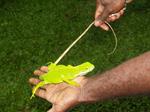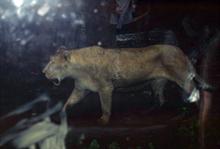Take a step forward to achieving your goal

Are you interested in working in a zoo?
Do you want to learn more about zoo keeping?
This could be the course for you...
This course is ideal for you if you have a passion for animals and are interested in starting a career with animals. Learn all about zoos and the principles of keeping animals in a zoo with our Zoo Keeping course. Learn how to care for and manage animals in captive environments. This course covers animal care, enclosure designs, captive breeding, human-animal interactions, education and conservation and many other considerations on upholding the wellbeing of animals that are in captivity.
If you have always dreamed of working with animals and need a starting point and foundation knowledge, then this Zoo Keeping course is perfect for you.
Lesson Structure
There are 9 lessons in this course:
- The Nature and Scope of Zoos
- Occupational Health and Safety in Zoos
- Captive Husbandry - Nutrition and Feeding
- Captive Husbandry - Health
- Captive Husbandry - Reproduction
- Captive Husbandry - Behaviour and Enrichment
- Human-Animal Interactions
- Enclosure Design and Maintenance
- Problem-based Learning Project - Environmental Enrichment
Each lesson culminates in an assignment which is submitted to the school, marked by the school's tutors and returned to you with any relevant suggestions, comments, and if necessary, extra reading.
Aims
- Describe the nature and scope of zoos as a source of education and conservation
- Develop appropriate procedures for managing occupational health and safety in a zoo, with a view to minimising risk to staff, animals and visitors
- Describe the nutritional requirements and feeding preferences of animals within zoos
- Determine health management measures required for a range of different captive zoo animals
- Describe the management of breeding in zoos
- Determine appropriate ways to manage a range of different wild animals in zoos
- Explain procedures and techniques used to manage human-animal interactions in zoos
- Identify and describe the qualities of good enclosure design. Develop maintenance
Issues with Handling Animals

When planning to handle animals, the benefits of handling should be weighed against possible harm to the animal, to other animals, or other potential costs. These costs can include specialised equipment, labour, and facilities, and methods for reducing the stress to the animal.
In addition to potential physical problems associated with handling, many of the issues that must be dealt with are psychological. Because we cannot communicate our intention or reassure the animal that the handling is in its own best interest (when it is) or otherwise necessary, and the animal may not even possess the faculties for understanding such issues anyways, we run the risk that the animal will perceive handling as stressful, and potentially dangerous, and act accordingly.
One way to reduce stress is to identify and utilise symbolic language (signals) that elicit more cooperative responses or reduce stress. These can include simple stroking (which can help calm Equids), whistling (dogs respond to short, high notes), lowering ourselves to their level (which can reduce anxiety in some animals), making familiar hand signals (with animals trained to respond in particular ways to the signals), and making soothing noises to which the animal has learned to respond.
Signals, voice, gestures, and stance can do much to help avoid fearful reactions. However, an animal can quickly become anxious in unfamiliar situations, and once frightened, are difficult to calm down.
Psychological Effects of Different Handling Techniques
When people interact with animals, they may change the animal’s behaviour. Some changes can be beneficial, while others can be detrimental. For example, wild animals can become excessively dependent upon humans, to their own detriment. Some animals may adopt behaviours which are not natural (such as a bird talking or a wild animal allowing humans to approach), which can put the animal in danger or isolate it from others of its kinds.
 There are recorded instances of chimpanzees that had learned to communicate with humans by sign language trying unsuccessfully to sign to other chimpanzees. Such training might override the animal’s natural methods of communication or feeding, making it particularly vulnerable. Also, restriction on natural movement can create psychological stress, may impair natural and necessary exercise patterns (eg. a lion kept in a small cage where it cannot run), and deprive the animal of its natural resources, which can lead to poor health. On the other hand, animals may learn useful skills which they might not have learnt in the wild.
There are recorded instances of chimpanzees that had learned to communicate with humans by sign language trying unsuccessfully to sign to other chimpanzees. Such training might override the animal’s natural methods of communication or feeding, making it particularly vulnerable. Also, restriction on natural movement can create psychological stress, may impair natural and necessary exercise patterns (eg. a lion kept in a small cage where it cannot run), and deprive the animal of its natural resources, which can lead to poor health. On the other hand, animals may learn useful skills which they might not have learnt in the wild.
Behavioural Disorders
It is perhaps easier to determine the existence of behavioural disorders in animals because we don't need to know what they are thinking. Behavioural disorders may become apparent through observing what an animal does. Animals sometimes display behaviours that are considered abnormal or disordered.
Compulsive behaviour - this is quite a common behavioural disorder in animals in captivity. In humans, this is manifested as OCD (obsessive compulsive disorder), but in animals it is impossible to suggest that they have the same intrusive obsessive thoughts and ritualistic behaviours that humans do. Instead, compulsive disorders in animals are when the animal engages in a specific, unnecessary series of actions that are repeated more often than we would normally expect. Such compulsive behaviours may also be referred to abnormal repetitive behaviour. They involve a repetitive pattern of stereotyped behaviours.
For example, a human may wash their hands repeatedly because they are obsessed with germs and dirt. A dog may lick and chew its paws repeatedly until they have no fur left, but we certainly cannot say that it is doing this because it is obsessed with dirt and being clean. Most likely, it is anxious or stressed. To consider the animal is obsessed with that behaviour is to anthropomorphise the behaviour.
Many animals will display repetitive and stereotypic behaviours. Some researchers argue that these forms of behaviour can occur when a normal, natural process goes too far.
Lick granuloma - this is a condition found in dogs, where the dog licks itself repeatedly until ulcers form on the skin. It usually appears in larger dogs.
 Stereotypies (Zoochosis) - the term zoochosis was first coined by Bill Travers, the actor and eventually animal rights activist, famous for starring in the film 'Born Free'. It is used to describe repetitive and apparently obsessive behaviour in zoo animals, or animals in artificial environments with little stimulation. It can result in a range of abnormal behaviours, such as:
Stereotypies (Zoochosis) - the term zoochosis was first coined by Bill Travers, the actor and eventually animal rights activist, famous for starring in the film 'Born Free'. It is used to describe repetitive and apparently obsessive behaviour in zoo animals, or animals in artificial environments with little stimulation. It can result in a range of abnormal behaviours, such as:
- Tongue playing – where the animal continually licks bars, gates or the wall. Often seen in giraffes and camels.
- Bar biting – repeated biting or rubbing of the mouth around the bars of an enclosure until it damages the mouth and teeth. This is often seen in bears.
- Neck twisting – where the animal unnatural twists and rolls its neck. Often seen in monkeys, llamas and giraffes.
- Pacing – where the animal walks back and forth along the same path. Often seen in big cats such as lions.
- Circling – is another form of pacing, where the animal places its feet in exactly the same position each time. This is often seen in bears and elephants.
- Vomiting – where an animal will repeatedly vomit, then eat the vomit. This is often seen in chimpanzees and gorillas.
- Coprophagia – the eating of faeces, often seen in captive gorillas and chimpanzees.
- Rocking – where the animal rocks backwards and forwards over and over. This is a recognised symptom in human mental illness and can be displayed in some animals, such as chimpanzees.
- Swaying - another behaviour also seen in humans with mental illness and can be seen in elephants and bears.
- Over-grooming - where the animal grooms itself to such an extent that it leaves bald patches where there is no fur or feathers, and often causes ulcers and broken skin.
- Self-injury and self-mutilation - where the animal inflicts physical harm on itself, such as biting or chewing its tail or leg, hitting its head against a wall, etc. Rhesus monkeys have been observed slapping, rubbing, biting and clasping themselves. Their self-aggression levels rise when they are put into stressful situations, such as moving from one cage to another, and impoverished environments.
An Experiential online course
Unlike other online courses, our courses offer you the added opportunity to apply your knowledge through activities encouraging you to undergo tasks, network with industry professionals, carry out extra research etc, giving you an experiential course. Compared with many other online courses, our courses are more in depth and the level of support you will receive is higher.

Where to now?
Study Zoo Keeping with our Experiential online course

Unlike other online courses, our courses offer you the added opportunity to apply your knowledge through activities encouraging you to undergo tasks, network with industry professionals, carry out extra research etc, giving you an experiential course. Compared with many other online courses, our courses are more in depth and the level of support you will receive is higher.
Register to Study -Go to panel toward top of this page (right column) to enrol.
or
Get Advice -Use our FREE COUNSELLING SERVICE to contact a tutor
CLICK TO CONTACT US
